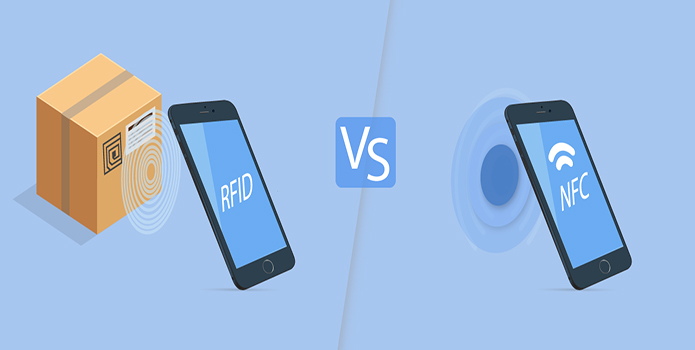The primary difference between RFID and NFC is that NFC works only with short distances (usually less than 10 cm), and it can be powered by capacitive energy transfer.
On the other hand, RFID uses the frequency of 125 kHz/13.56 MHz and requires a power source (battery or induction coil). It offers a maximum range of 100 meters.
Besides these differences, the technologies are pretty similar. This article gives an in-depth comparison between NFC and RFID.
Was ist RFID?
RFID (Radio Frequency Identification) is a wireless non-contact technology that uses electromagnetic fields to transfer data from the Tag (transponder) to the Reader (interrogator).
The two main components of an RFID system are a tag and a reader device, each having an antenna. The transmission medium is the air interface.
It works at very high frequencies (125 kHz/13.56 MHz). As such, it allows large amounts of data to be transferred quickly between two transponders or between a transponder and a reader.
What are the Applications of RFID?
Es gibt viele Anwendungen von RFID. Es kann verwendet werden, um den Zutritt in verschiedenen Bereichen, wie Industrieanlagen oder Fabriken, zu koordinieren und zu kontrollieren. Als solche können diese Tags die Produktivität industrieller Prozesse verbessern und Abfall reduzieren, indem sie die Verwendung von Rohstoffen und Fertigprodukten überwachen.
Es ist auch nützlich bei der Verwaltung und Überwachung von Vermögenswerten, wie z. B. gewerblichen Lastwagen oder Containern in Häfen oder Flughäfen. So vermeiden Sie Verluste durch Diebstahl oder unsachgemäße Handhabung.
Wenn ein Unternehmen beispielsweise mehrere Lager hat, kann es seine Waren überall orten, indem es einfach ein RFID-Lesegerät am Eingang jedes Lagers installiert.
Die RFID-Technologie kann auch in vielen anderen Bereichen eingesetzt werden, wie zum Beispiel:
- Identifizierung und Zugangskontrolle
- Fahrzeugverfolgung
- Verfolgung von Tieren/Haustieren,
- Zahlungssysteme (Integration mit Kreditkarten) und Mobiltelefone
Was ist NFC?
NFC (Near field communication) is a wireless communication technology that allows two electronic devices closely placed (up to 4 cm) to establish communication and exchange data.
It is related to RFID but it works at lower frequencies (13.56 MHz). They allow large amounts of data to be transferred quickly between two transponders almost simultaneously.
NFC is comparable to Bluetooth, Infrared (IR), and Wireless LAN standards. Although each of these technologies has its protocol standard, they all establish communication using electromagnetic fields.
This technology requires short-range, so it is used to create wireless connections between small portable devices such as mobile phones or tablets.
What are NFC Tags?
An NFC tag contains information that different applications can access – usually through an NFC Service ID assigned by the manufacturer, depending on what service this tag will offer.
They have an NFC chip and an antenna embedded in a label or printed directly on a surface. The tag can be read from up to 20 cm (7.9 in) away by an active NFC device such as modern smartphones.
What are the Applications of NFC?
NFC hat mehrere Anwendungen, einschließlich Dateiübertragung zwischen Smartphones, Zahlungssystemen, Ticketing für öffentliche Verkehrsmittel und kontaktbehafteten Zugangskontrollkarten.
Zusätzlich können an bestimmten Stellen NFC-Lesegeräte für eine schnelle Datenübertragung angebracht werden. Ein Beispiel hierfür sind Geldautomaten, an denen Sie Ihre Kreditkarte an ein Lesegerät halten müssen, damit es einige nützliche Informationen wie Kontonummer, Ablaufdatum und Sicherheitscode lesen kann.
Auf diese Weise ist ein Online-Einkauf sicher, da niemand Ihr Passwort oder Ihr Bankkonto während der Zahlung stehlen kann – es sei denn, er erhält Zugriff auf das NFC-Gerät (ATM), das Ihre Bankdaten speichert.
Andere Anwendung für NFC-Tags ist in der Werbung. Viele Unternehmen wollen ihre Botschaft verbreiten, aber nicht jeder hat genug Geld, um Fernsehwerbung zu kaufen. Diese Unternehmen stellen spezielle Artikel her, die das Firmenlogo mit einem darin eingebetteten NFC-Tag enthalten – wenn also jemand mit einem NFC-fähigen Mobiltelefon in die Nähe geht, wird das Tag gescannt und eine Nachricht erscheint.
NFC-Tags kann auch zum Starten von Anwendungen oder bestimmten Aktionen auf Ihrem Gerät verwendet werden. Möglicherweise haben Sie dies an öffentlichen Orten in Aktion gesehen, an denen Sie aufgefordert werden, Ihr Telefon nicht zu benutzen, sondern es gegen ein Lesegerät zu halten.
Ein Beispiel dafür ist Google Wallet, wo Sie Online-Einkäufe tätigen können, indem Sie Ihr Handy gegen ein NFC-Lesegerät halten. Diese Aktion veranlasst Google Wallet, die erforderlichen Daten zu übertragen, um die Transaktion abzuschließen.
RFID vs. NFC – What is The Difference?
These technologies work on the same principle: sending and receiving data without any physical contact. While their speeds are very close, RFID is faster for a wide read range while NFC works in a smaller area.
Both RFID and NFC do not require a direct line of sight. As such, you can read the tags from whichever angle you find convenient. This feature makes the tag more reliable and faster compared to barcodes.
However, there are a few differences between RFID and NFC, including:
- Frequency of Operation. NFC operates only at 13.56 MHz while RFID can operate within a frequency range of 134.2 kHz to over 900 MHz.
- Read Range. NFC operates optimally when the reader and the tags are a maximum of 10 cm away from each other. This short read range limits NFC to data exchange, contactless payments, and proximity cards. On the other hand, RFID tags can have a read range of up to 100 meters, thus making them ideal for tracking.
- Memory. RFID tags have a larger memory capacity than NFC. The feature makes them useful where you need to store massive amounts of data. Most RFID tags are not writable so it will be hard to change the data on there without erasing everything and writing it again. However, you can get one with write/read abilities.
- Functionality. RFID deals particularly with identification while NFC deals with communication. RFID is ideal for processing large amounts of data within a short time.
Both NFC and RFID are highly reliable. However, you should define your needs before you settle for one. If you need one for identification and access control, then we recommend RFID. If you need one for communication and data exchange, then you should choose NFC.
In Verbindung stehende Artikel
- So programmieren Sie NFC-Tags
- Was ist NFC-Zahlung?
- Telefone mit NFC im Jahr 2021 – Liste der NFC-fähigen Mobilgeräte
- So verwenden Sie NFC auf dem iPhone – Folgendes müssen Sie wissen!
- Die 12 besten NFC-Tag-Anwendungen, die Ihr Leben zum Vergnügen machen
- NFC vs. RFID: Was ist der Unterschied zwischen ihnen?
- Erfahren Sie alles über verschiedene Arten von RFID-Tags
- Ein Leitfaden für Anfänger – Was ist ein NFC-Tag?


